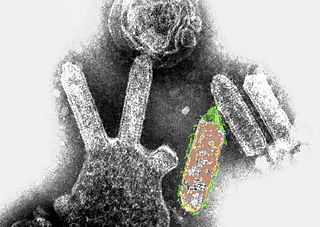
The United States Secretary of Health and Human Services is the head of the United States Department of Health and Human Services, concerned with health matters. The Secretary is a member of the President's Cabinet. The office was formerly Secretary of Health, Education, and Welfare.

Tuskegee Study of Untreated Syphilis in the Negro Male was a clinical study conducted between 1932 and 1972 by the U.S. Public Health Service. The purpose of this study was to observe the natural history of untreated syphilis; the African-American men in the study were only told they were receiving free health care from the United States government.
The management of HIV/AIDS normally includes the use of multiple antiretroviral drugs in an attempt to control HIV infection. There are several classes of antiretroviral agents that act on different stages of the HIV life-cycle. The use of multiple drugs that act on different viral targets is known as highly active antiretroviral therapy (HAART). HAART decreases the patient's total burden of HIV, maintains function of the immune system, and prevents opportunistic infections that often lead to death. HAART also prevents the transmission of HIV between serodiscordant same sex and opposite sex partners so long as the HIV-positive partner maintains an undetectable viral load.

The United States Public Health Service (USPHS) is a division of the Department of Health and Human Services concerned with public health. It contains eight out of the department's eleven operating divisions. The Assistant Secretary for Health (ASH) oversees the PHS. The Public Health Service Commissioned Corps (PHSCC) is the federal uniformed service of the USPHS, and is one of the seven uniformed services of the United States.
Chlordane, or chlordan, is an organochlorine compound used as a pesticide. It is a white solid. In the United States, chlordane was used for termite-treatment of approximately 30 million homes until it was banned in 1988. Chlordane was banned 10 years earlier for food crops like corn and citrus, and on lawns and domestic gardens.

Health care, health-care, or healthcare is the maintenance or improvement of health via the prevention, diagnosis, and treatment of disease, illness, injury, and other physical and mental impairments in people. Health care is delivered by health professionals in allied health fields. Physicians and physician associates are a part of these health professionals. Dentistry, pharmacy, midwifery, nursing, medicine, optometry, audiology, psychology, occupational therapy, physical therapy and other health professions are all part of health care. It includes work done in providing primary care, secondary care, and tertiary care, as well as in public health.
A patient is any recipient of health care services. The patient is most often ill or injured and in need of treatment by a physician, nurse, psychologist, dentist, veterinarian, or other health care provider.
The ultraviolet index or UV Index is an international standard measurement of the strength of sunburn-producing ultraviolet (UV) radiation at a particular place and time. The scale was developed by Canadian scientists in 1992, and then adopted and standardized by the UN's World Health Organization and World Meteorological Organization in 1994. It is primarily used in daily forecasts aimed at the general public, and is increasingly available as an hourly forecast as well.

Australian bat lyssavirus (ABLV) is a zoonotic virus closely related to the rabies virus. It was first identified in a 5-month-old juvenile black flying fox collected near Ballina in northern New South Wales, Australia, in January 1995 during a national surveillance program for the recently identified Hendra virus. ABLV is the seventh member of the genus Lyssavirus and the only Lyssavirus member present in Australia.
Health human resources (HHR) – also known as human resources for health (HRH) or health workforce – is defined as "all people engaged in actions whose primary intent is to enhance health", according to the World Health Organization's World Health Report 2006. Human resources for health are identified as one of the core building blocks of a health system. They include physicians, nursing professionals, midwives, dentists, allied health professions, community health workers, social health workers and other health care providers, as well as health management and support personnel – those who may not deliver services directly but are essential to effective health system functioning, including health services managers, medical records and health information technicians, health economists, health supply chain managers, medical secretaries and others.
The hospitality industry is a broad category of fields within the service industry that includes lodging, food and drink service, event planning, theme parks, transportation, cruise line, traveling, airline and additional fields within the tourism industry.

The U.S. Army Research Institute of Environmental Medicine (USARIEM) is the U.S Army’s main institution and facility for military environmental medicine and exercise physiology research. It is located at Natick, Massachusetts, within the U.S. Army Soldier Systems Center (SSC) installation, but is a subordinate lab of the U.S. Army Medical Research and Materiel Command (USAMRMC), headquartered at Fort Detrick, Maryland, USA.
VectorBase is one of the five Bioinformatics Resource Centers (BRC) funded by the National Institute of Allergy and Infectious Diseases (NIAID), a component of the National Institutes of Health (NIH), which is an agency of the United States Department of Health and Human Services. VectorBase is focused on invertebrate vectors of human pathogens working with the sequencing centers and the research community to curate vector genomes.

Benzo[j]fluoranthene (BjF) is an organic compound with the chemical formula C20H12. Classified as a polycyclic aromatic hydrocarbon (PAH), it is a colourless solid that is poorly soluble in most solvents. Impure samples can appear off white. Closely related isomeric compounds include benzo[a]fluoranthene (BaF), bendo[b]fluoranthene (BbF), benzo[e]fluoranthene (BeF), and benzo[k]fluoranthene (BkF). BjF is present in fossil fuels and is released during incomplete combustion of organic matter. It has been traced in the smoke of cigarettes, exhaust from gasoline engines, emissions from the combustion of various types of coal and emissions from oil heating, as well as an impurity in some oils such as soybean oil.

This article is about climate change, industry and society.
Health care fraud includes health insurance fraud, drug fraud, and medical fraud. Health insurance fraud occurs when a company or an individual defrauds an insurer or government health care program, such as Medicare or equivalent State programs. The manner in which this is done varies, and persons engaging in fraud are always seeking new ways to circumvent the law. Damages from fraud can be recovered by use of the False Claims Act, most commonly under the qui tam provisions which rewards an individual for being a "whistleblower", or relator (law).
Ann Reed Mangels is a registered dietitian and Adjunct Associate Professor in the Department of Nutrition in the School of Public Health and Health Sciences at the University of Massachusetts Amherst, specializing in vegan and vegetarian nutrition. She is the author or co-author of numerous papers and books on the subject, including the American Dietetic Association's position paper on vegan and vegetarian diets, Vegan & Vegetarian FAQ (2001), The Dietitian's Guide to Vegetarian Diets (2004), and The Everything Vegan Pregnancy Book (2011).
i-Tree is a collection of urban and rural forestry analysis and benefits assessment tools. It was designed and developed by the United States Forest Service to quantify and value ecosystem services provided by trees including pollution removal, carbon sequestration, avoided carbon emissions, avoided stormwater runoff, and more. i-Tree provides baseline data so that the growth of trees can be followed over time, and is used for planning purposes. Different tools within the i-Tree Suite use different types of inputs and provide different kinds of reports; some tools use a 'bottom up' approach based on tree inventories on the ground, while other tools use a 'top down' approach based on remote sensing data. i-Tree is peer-reviewed and has a process of ongoing collaboration to improve it.
Mentally ill people are overrepresented in United States jail and prison populations relative to the general population. There are three times more seriously mentally ill persons in jails and prisons than in hospitals in the United States. The exact cause of this overrepresentation is disputed by scholars; proposed causes include the deinstitutionalization of mentally ill individuals in the mid-twentieth century; inadequate community mental health treatment resources; and the criminalization of mental illness itself. The majority of prisons in the United States employ a psychiatrist and a psychologist. While much research claims mentally ill offenders have comparable rates of recidivism to non-mentally ill offenders, other research claims that mentally ill offenders have higher rates of recidivism. Mentally ill people experience solitary confinement at disproportionate rates and are more vulnerable to its adverse psychological effects. Twenty-five states have laws addressing the emergency detention of the mentally ill within jails, and the United States Supreme Court has upheld the right of inmates to mental health treatment.







